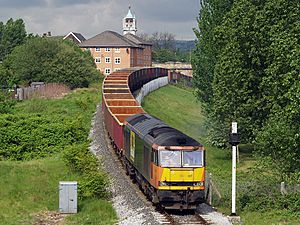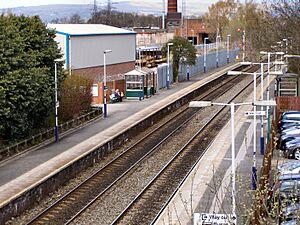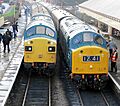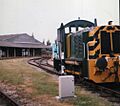East Lancashire Railway facts for kids
Quick facts for kids East Lancashire Railway |
|||||
|---|---|---|---|---|---|
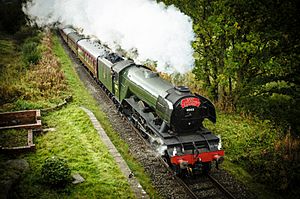
The famous 60103 Flying Scotsman steams towards Rawtenstall.
|
|||||
| Locale | North west England | ||||
| Terminus | Rawtenstall and Heywood |
||||
| Connections | Network Rail (east of Heywood, via Castleton) Manchester Metrolink (south of Bury) |
||||
| Commercial operations | |||||
| Name | East Lancashire Railway | ||||
| Built by | East Lancashire Railway (1844–1859) | ||||
| Original gauge | 4 ft 8 1⁄2 in (1,435 mm) standard gauge | ||||
| Preserved operations | |||||
| Operated by | East Lancashire Light Railway Company (ELLR Co.) | ||||
| Stations | 7 | ||||
| Length | 12 miles 45 chains (20.2 km) | ||||
| Preserved gauge | 4 ft 8 1⁄2 in (1,435 mm) standard gauge | ||||
| Commercial history | |||||
| Opened | 1846 | ||||
| Closed | 17 March 1980 | ||||
| Preservation history | |||||
| 31 March 1986 | Granted Light Railway Order (for public service) | ||||
| 25 July 1987 | Re-opens and public service begins | ||||
| 27 April 1991 | Extension to Rawtenstall | ||||
| 6 September 2003 | Extension to Heywood | ||||
| 13 October 2016 | New halt opened at Burrs Country Park | ||||
| Headquarters | Bury Bolton Street | ||||
|
|||||
The East Lancashire Railway (ELR) is a special type of railway called a heritage railway. This means it preserves and runs historic trains for everyone to enjoy. The line is about 12.5 miles (20 km) long and travels through the beautiful countryside of North West England, between the towns of Heywood and Rawtenstall.
Along the way, the trains stop at several restored stations, including Bury Bolton Street, Burrs Country Park, Summerseat, Ramsbottom, and Irwell Vale. It's a journey back in time on wheels!
The railway connects with the main national train network near Heywood, and there are exciting plans to extend the line to make it even easier for people to visit.
Contents
The Story of the Railway
The original train service between Bury and Rawtenstall was stopped by British Rail in 1972. For a while, the tracks were only used for hauling coal, but even that ended in 1980. The line was officially closed, and it seemed like the end of an era.
However, a group of dedicated volunteers, called the East Lancashire Railway Trust, decided to save it. They worked hard to bring the railway back to life, and on 25 July 1987, the first section reopened between Bury and Ramsbottom.
Over the years, the railway grew. In 1991, the line was extended north to Rawtenstall. Then, in 2003, it was extended east from Bury to Heywood. This new section included a very steep bridge over the Manchester Metrolink tram line, which drivers nicknamed "The Ski Jump" because of its sharp slopes!
More recently, in 2016, a new station was opened at Burrs Country Park. The world-famous steam engine, the Flying Scotsman, pulled the very first train to stop there.
Fun Events and Volunteers
The railway is open every weekend and hosts many fun events all year round. There are special days for steam and diesel train fans, and even "Day Out with Thomas" events where you can meet Thomas the Tank Engine.
The entire railway is run by volunteers from the East Lancashire Railway Preservation Society. They do everything from driving the trains to fixing the engines and carriages. The ELR is famous for its large collection of historic diesel locomotives, as well as over 140 carriages and wagons.
Stations on the East Lancashire Railway
Here are the main stations you can visit on the railway, plus some that are now closed.
| Point | Coordinates (Links to map resources) |
OS Grid Ref | Notes |
|---|---|---|---|
| Castleton | 53°35′31″N 2°10′42″W / 53.5919°N 2.1783°W | Network Rail (extension planned) |
|
| Heywood | 53°35′20″N 2°12′25″W / 53.5889°N 2.2069°W | ||
| Broadfield | 53°35′11″N 2°13′49″W / 53.5863°N 2.2302°W | Closed | |
| Bury Knowsley Street | 53°35′21″N 2°17′57″W / 53.5893°N 2.2991°W | Closed | |
| Bury Bolton Street | 53°35′36″N 2°17′59″W / 53.5934°N 2.2997°W | ||
| Burrs Country Park | 53°36′39″N 2°18′14″W / 53.6108°N 2.3038°W | ||
| Summerseat | 53°37′39″N 2°18′52″W / 53.6275°N 2.3145°W | ||
| Ramsbottom | 53°38′51″N 2°18′53″W / 53.6474°N 2.3146°W | ||
| Stubbins | 53°39′29″N 2°19′00″W / 53.6580°N 2.3168°W | Closed | |
| Irwell Vale | 53°40′37″N 2°18′58″W / 53.6769°N 2.3160°W | ||
| Ewood Bridge and Edenfield | 53°41′00″N 2°18′32″W / 53.6832°N 2.3088°W | Closed | |
| Rawtenstall | 53°41′56″N 2°17′32″W / 53.6988°N 2.2923°W |
Future Plans for the Railway
The ELR has big plans for the future. The main goal is to extend the line from Heywood to Castleton. This would create a new station where passengers could easily switch between the heritage railway and modern Network Rail trains.
This project has support from local councils and the government. In 2020, the plan to reopen the route between Rochdale and Bury was approved to move forward as part of the government's 'Restoring Your Railway' project. This would help more people visit the railway and better connect the local communities.
Meet the Engines
The ELR is home to a fantastic collection of steam and diesel engines. Some are owned by the railway, while others are owned by private collectors who keep them there.
Steam Locomotives
These engines are powered by burning coal to create steam. They are the stars of the show for many visitors!
Engines You Can See in Action
| Number & Name | Type | Photograph | Livery | Fun Fact |
|---|---|---|---|---|
| 34092 City of Wells | SR West Country Class 4-6-2 |  |
BR Lined Green | Built in 1949, this powerful engine is a regular sight on the line. |
| 32 Gothenburg | Manchester Ship Canal 0-6-0T | 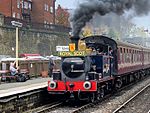 |
North Western Railway Blue | Built in 1903, this engine is often dressed up as Thomas the Tank Engine for special events. |
| 80097 | BR Standard Class 4 2-6-4T | 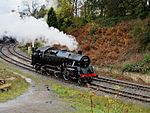 |
BR Lined Black | This engine was saved from a scrapyard and carefully restored. It returned to service in 2019. |
| 52322 | L&YR Class 27 0-6-0 |  |
BR Unlined Black | An old engine built way back in 1895 at Horwich Works. It was recently overhauled. |
Engines Being Repaired or Stored
The railway has many other steam engines that are being stored or restored. This includes engines like the huge 35009 Shaw Savill and the powerful GWR 2884 Class 2-8-0 No. 3855, which are being brought back from scrapyard condition. This important work ensures these historic machines can run again one day.
Diesel Locomotives
The ELR has one of the biggest collections of preserved diesel engines in the UK. These engines, from the 1950s and 60s, represent a different era of railway history.
Engines You Can See in Action
| Number & Name | Type | Photograph | Livery | Fun Fact |
|---|---|---|---|---|
| D9531 'Ernest' | BR Class 14 | 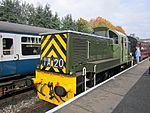 |
BR Two-tone Green | A small but strong shunting engine, looked after by the Bury Hydraulic Group. |
| D5054 (24054) 'Phil Southern' | BR Class 24 | 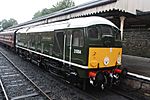 |
BR Green | A classic diesel from 1959 that used to work on main lines across Britain. |
| 345 (40145) | BR Class 40 | 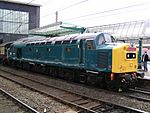 |
BR Green | A large, impressive engine known as a "Whistler" by fans because of its engine sound. |
| D832 'Onslaught' | BR Class 42 |  |
BR Blue | This type of engine used a special hydraulic system instead of an electric one to turn its wheels. |
Diesel Multiple Units (DMUs)
These are trains where the engine is built into one of the carriages.
- Class 104 unit: A classic 1950s design, painted in BR Blue.
- Class 105 unit: Another 1950s train, painted in BR Green.
- Class 144 unit: A more modern "Pacer" train from the 1980s.
Electric Trains
The ELR even has a rare electric train from the 1950s.
- Class 504 unit: This train used to run on local lines around Manchester. It is being restored at the railway.
Images for kids



